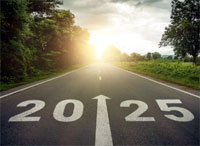Once Christmas has passed, the world looks to a new year. Many wonder what the new year will bring while planning their own ways of ringing in 2025. Some will mark the new year quietly while others will celebrate with friends and family.

Observances of the new year date back thousands of years as ancient peoples recognized the regular shifting patterns of stars at night and the sun in the day and their connection to particular seasons. The earliest observances of January 1 for the beginning of the year began with the Romans around 713 BC. The Romans named the first month of their lunar calendar year January after the Roman god Janus, who supposedly was the god of time and also the god of beginnings and transitions. According to legend, Janus had two faces, one looking into the past and the other looking into the future. It was a day marked with great celebrations.
In New York City, the famous dropping of the Times Square Ball will mark the new year. It is a tradition dating back to New Year’s Eve 1907 when Adolph Ochs, then owner of The New York Times, devised it as a way of celebrating the new year by having the glass ball lowered on the roof of his newspaper building. The modern ball, its fifth incarnation, is glass, twelve feet in diameter, and weighs nearly 12,000 pounds. It was manufactured by Waterford Crystal and has more than 32,000 LED lights illuminating it. It is the most popular new year’s observance in the United States, with up to one million people attending in person each year.
The tradition of Rosh Hashanah marks the tradition of the Jewish new year, which means “head of the year” in Hebrew, a tradition dating back to the Old Testament. This holiday is not observed in January but sometime in September or October, depending on the lunar calendar. The two-day celebration includes many symbolic foods, including apples dipped in honey to mark a sweet new year. It is a national holiday only in Israel and Ukraine. In 2025, it will begin at sunset on September 23.
For the Hopi and Zuni tribes of the Southwest, the new year is traditionally celebrated on the winter solstice, December 21. It is marked with prayers, rituals, and feasts, all of which can last up to nine days.
The Navajo observe the new year with the new moon in October, usually the first new moon after the beginning of fall.
In most countries throughout the world, January 1 is an official holiday to mark the beginning of the new year. Even many non-western countries will observe January 1 as New Year’s Day because of the overwhelming influence of European and American business and culture for the past few centuries as they ultimately adopted the modern Gregorian calendar used throughout the West, even in officially atheist nations like China.
The Chinese New Year will not start until January 29. Under the Chinese Zodiac system dating back many centuries, 2025 will mark the Year of the Snake. In China, the snake is associated with intelligence but also trickery and deceit. In China, fireworks are set off to mark the new year and to also scare off demons and forces of darkness. In China, families often gather to celebrate the new year.
Similarly, January 29 will mark the traditional Vietnamese New Year, known as Tet. The Vietnamese lunar calendar is very similar to the Chinese calendar. The Vietnamese Zodiac also makes 2025 the Year of the Snake. By tradition, a great feast is prepared, family reunions are held, and many celebrations are held in cities across the country. Many in Vietnam see Tet as the beginning of spring as well. Cleaning the home is also part of the traditional observances to symbolically clean out the bad spirits from the previous year.
Different types of food are also associated with the New Year’s celebrations. In India, rice is eaten for prosperity in the new year. Buttered bread is supposed to be good luck in Ireland. In Spain, people traditionally eat 12 grapes at midnight, one at each chime, to bring luck for the year. In the American South, black-eyed peas are eaten for good luck for the new year. Leafy green vegetables like collard greens are supposed to symbolize prosperity. In Scotland, gifts of silverware or pastries are traditionally given for luck. In the Philippines, Christmas and New Year’s Day celebrations are often combined.
Many celebrations will mark the beginning of the year as the world heads into the future.

